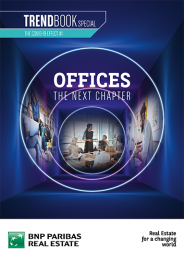However, despite the fact that these tools allow us to keep communication lines open, video simply cannot replace the social cues and experiences that we have during a face-to-face conversation. Many have complained of ‘video fatigue’, partly brought on by the amount of time spent on video calls and the difficulty we face in decrypting body language onscreen, particularly when faced with multiple people on a screen.
What kind of office will we go back to?
The lockdown imposed on many countries is now starting to recede and as we begin to emerge again into a world notably changed by months of lockdown and uncertainty, people are starting to go back to the office, albeit tentatively.
We know that the offices we are going to go back to will be different from the ones we left. When in the early 20th century the idea of the open plan office was made popular, it changed the way we worked. The office space was democratised and collaboration between employees became easier than ever. This trend has continued, as offices across the world saw the benefits, some even completely breaking down meeting rooms to create flexible working space. Then came Covid-19. Suddenly this open space, full of people, was perceived differently, seen through the tinted vision of an invisible threat. One study by South Korea’s Centers for Disease Control shows how easily Covid-19 can spread throughout an office, with 94 out of 216 employees on one floor of a call centre testing positive for the virus.
This means that changes will have to be made to stop the easy transmission of the virus. Offices will be transformed, and indeed BNP Paribas Real Estate has issued guidelines for what that return to the office must look like, including the wearing of masks, the reduction of people using company restaurants and the spacing out of employees at their workspaces.
Going back to work will be progressive
Despite the changes that we have witnessed to our society and the new concept of social distancing, offices are once again beginning to fill up. According to data published by BNP Paribas Real Estate Property Management, the differences in numbers going back vary from country to country and are intrinsically linked to their response and indeed the severity of the pandemic in the country. As of 14th May, in the UK and Ireland only 0-5% of offices had any physical occupation, whilst in Germany and Hungary occupation is up to 25-50%. France, whose lockdown lifted on 11th May currently stands at 10-15% and Italy and Spain, who saw some of the worst numbers of cases, remain cautious at 5-10% occupation.
This is of little surprise of course, in a study conducted by IFOP for BNP Paribas Real Estate, three out of four of the 1,508 French people that were interviewed indicted that they would favour a progressive return to the office. We know that offices will gradually be filled up again, and that social distancing will become a part of the office building but how to maintain the values of the office building? The office building is there for a reason; to bring people together and to encourage collaboration and fluid communication. So how do we ensure this whilst remaining safe in our workplaces?
Remote and office work will go hand in hand
For many, working from home has been a positive experience. The same IFOP study found that 72% have had a good experience of it and a Slack study conducted with 2,877 knowledge workers in America found that 60% believed they were more productive working from home than in the office. However, the impact of quarantine cannot be underestimated, with many people suffering isolation, anxiety and loneliness during this time. The desire to get back outside has been evidenced by the large crowds seen outside, enjoying the freedom of walking around and seeing loved ones, when cities such as Paris have reopened. Working from home may be integrated into our working experience but it is unlikely to become the rule of thumb.
This begs the question of how to ensure social distancing without losing the social element? We must remember that we are physically distancing from others, not distancing ourselves socially. The office will more than ever be a place to converge and to appreciate colleagues and the human contact that it enables us to have. With perhaps more time spent working from home, time in the office will be precious.
To allow this interaction, many architects have already started to imagine how we can socially distance in cities and towns without feeling constrained, with inventive ideas for private spaces in restaurants and picnic blankets that mark out a distance of 2 metres. This concept may well come to the office, as interaction is encouraged through new office design and perhaps a range of digital tools which allow the merging of remote working and working in the office.
The British Council for Office has, for example, called for short and long-term changes to be made to the office, meaning that the trend for the open plan office which has prevailed for nearly 100 years may be coming to an end. It is however by endorsing the office as a place of socialisation and of collaboration that these changes can be made, in line with what works best for those using the building. How these changes are perceived and how they will continue to evolve remains to be seen.

TrendBook Offices: the next chapter
What is life in our offices going to look like post Covid?
Take a deeper look at the trends, innovations and new ways of interacting with space that are going to affect our professional spaces.




